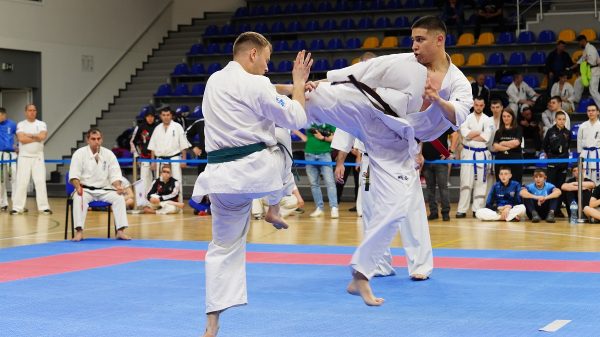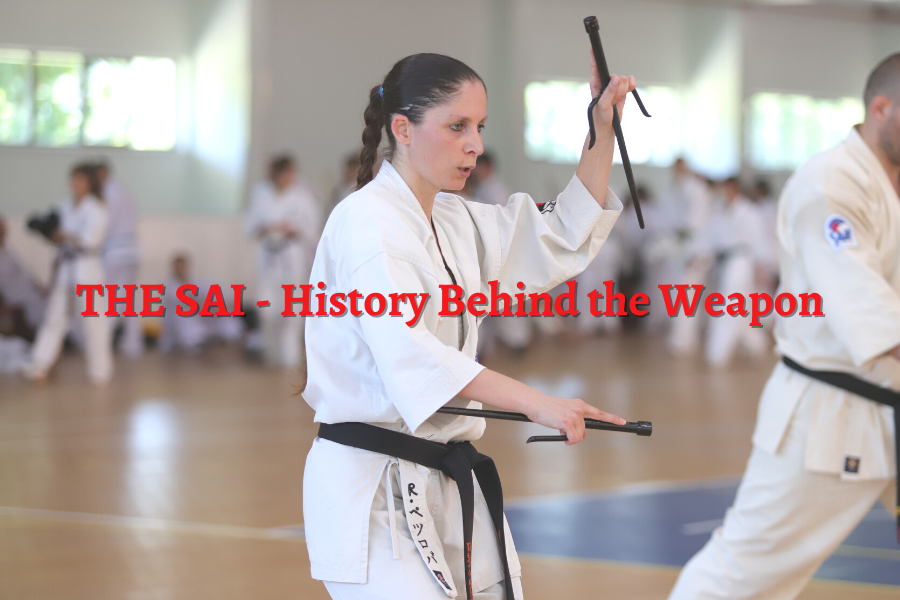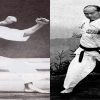Sai is a metal weapon and belongs to a type of dagger which is usually used in pairs, each hand using one. It is similar to a short sword, i.e. a trident dagger, but is traditionally blunt on its top. Its optimal length usually depends on the length of the user’s forearm. Most often, its length varies from 37 to 50 cm, as well as its weight which ranges from 1.5 to around 2 kg. Two shorter tines (shields) on each side on the dagger’s handle are turned upwards and are used for blocking, catching, and breaking the attacker’s weapon, for example, a stick, knife, dagger, halberd, or a Samurai sword – katana.
The Sai dagger has a couple of different models (apart from four basic ones, there are a few modifications) and its choice and usage depend on the procedure one wishes to execute with a certain martial technique, i.e. it depends on the goal which wants to be obtained by the technique. For example, blocking an attack, defending oneself from an armed attacker, hitting the opponent, shooting at the opponent with a dagger, apprehending the opponent, or breaking the opponent’s weapon.
It is believed that the Sai dagger was made as a shorter version of the trident. The trident was a well-known and popular weapon among many nations across the world. The history of the trident is extremely long and very interesting. In many world mythologies, one of the most popular deities, i.e. gods who used the trident was certainly the Ancient Greek god of sea and lightning – Poseidon as well as the Ancient Roman god Neptune. The trident owned a certain symbolism in the hands of Poseidon because it represented a division of power and dominion among three gods- brothers by the power of which they ruled. Zeus ruled the land and the skies, Had ruled over the underworld and Poseidon ruled over the seas.
Also, it is known that in Indian mythology some gods used the trident which, in the Sanskrit language, is called trishula or trisula. According to some theories, the trishula (trident) represents three philosophical texts found in Indian Veda’s called Sattvika, Rajasika, and Tamasika. It is interesting that, in Indian – Hindu mythology, the god Indra used the trident and he is also known as the god of lightning. In the later Buddhist period, this role was taken over by the god Shiva.
The trident is often quoted as a weapon in various parts of the world. So, for example, in Ancient Rome, famous gladiators called retario were armed with a trident and a net. Also, in Korea during the 17th and 18th-century fights with a trident called Dangpa are also mentioned. Statues of tomb guards in China which date from the time of the arrival of Buddhism to that area are also armed with tridents. This can also be seen on certain reliefs which represent tomb guards. As a weapon, the trident had a certain philosophical meaning even in the Taoist philosophy in China. According to the basic traditional martial arts which were used there (there are 18), the trident is also one of them. Also, in Japan, an old fighting technique is also popular and it is mentioned in the Nin Jutsu skill under the name of Sasu Mata Jutsu (a fishgig with three or four prongs).
In early Indian mythology and somewhat later in China, it is evident that various reliefs depict a dagger which is, in its form, very similar to the Sai dagger and which was used as a weapon by different Hindu gods. Later on, it was adopted by some Buddhist monks. Some historians believe that today’s Sai, in fact, derives from a short sword which the Hindu god Indra holds in his hand. This is clearly shown on relief in Java. Also, visualization of some early Indian gods using a trident in the form of the Sai dagger is also present on pictures that represent them. A painting of the god Indra found in Tiruchirappalli dated in 1820 or a painting which shows the god of love- the Kama with the ruler of hell- Yama which was made in the same year can be taken as examples.
A painting of the god Shiva with a dagger-trishula dated around 1590 was found in Harivamse. Today, the paintings are located in the Victoria and Albert Museum in London.
It is assumed that a dagger with such a shape represented the trinity which the god Indra brought together by making three steps- a step on earth, in the air and sky, by which he connected them. According to a different interpretation of the legend, the dagger represents the trinity of energy- the sun, lightning, and fire (because Indra was the god of lightning).
A differently shaped- model of the Sai dagger has the tines reversed in opposite directions in a way that one shield is facing upwards while the other one is directed towards the ground. It is called a Manji Sai or Nunti Sai. In contrast to a traditional handle, this model has a handle that is identical to the dagger so that it can be spun and used equally on both sides. It can sometimes be attached to a spear and used as its point because it is handy for defending oneself from various weapons. Such a form of the spear is known in Japan as Nunti- Bo and the skill in which it is used is Nunti- Jutsu. There are legends that say how Nunti Bo was designed by fishermen and was used as a tool for catching fish (just like Sasu Mata).
Sai weapon
According to some legends, a dagger with such a shape also represented a sort of a trinity. However, in this case, a trinity according to Buddhist belief and conceptualization of the world. The Buddhist world is called Cakravala and it has three levels- above, around and underneath the Meru mountain. So, this type of the Sai dagger, in some ways, signifies the Buddhist understanding of the Meru trinity. In accordance, the branch that stems downwards represents hell, i.e. the underworld, the middle and upward branch represents reincarnation and rebirth whereas the dagger’s very top represents a kind of nirvana, i.e. the fusion of the soul and the universe.
A legend according to which the Sai dagger got its shape thanks to the human body is well- known and it can be noticed that it (Sai) has a head, arms, body, and legs. Also, according to one of those legends, a god (Indra, Shiva) gave the Sai to men so that they could use it if needed. The legend says that Sai was a gift from God that was used by people for self-defense. Because of that, various Buddhist monks, when in need to protect themselves or their temple, used a trident, i.e. a Sai dagger.
Because of the need to use a dagger of such sorts, the skills of using a dagger for self-defense were born. Over some time, such daggers became famous in India, in some parts of Indonesia, Thailand, Malaysia, Vietnam. Also, they were called by different names, such as Tekpi or Tja Bang, and, in Indochina and China, Titi Djo (in some places, they were called Chai).
A lesser-known fact is that, somewhere around 1350, a similar dagger was made in Italy. The dagger was used in combination with a sword. Some historians connect this type of Italian dagger with the return of Marco Polo.
It is certain that the most famous skill of using this dagger is known under the Japanese term Sai (sometimes Chai).

The Sai dagger is constituted of a couple of parts that hold the following Japanese names: the handle is called Tsuka and its very end Tsukagashira; the tines (shields) are called Yoku; the central point where the branches meet is called Moto; a sole branch of the dagger is the Monotsuki and the top of the dagger Saki. The Sai dagger can have a round, hexagonal or octagonal shape.
Parts of the sai
The basic difference between Chinese and Indonesian (Tekpi, Tja Bang, Titi Djo, Chai) in contrast to the Japanese models (Sai, Chai) is not only in their smaller size and weight but also in the fact that they are almost always of a round shape, whereas Japanese daggers are hexagonal or octagonal. It is interesting that the identical difference exists regarding another famous weapon- the Nunchaku sticks. There is also a basic difference between the Tekpi dagger in comparison to the traditional Sai, Titi Djo, or Tja Bang which is noted in its sharpness. This is the reason why we can say that the so-called Manji sai version of the Sai dagger (Nunti Sai) looks more like a Tekpi dagger than a traditional Sai.
According to some stories, the Sai dagger was also used as a tool in agriculture, for example, when planting rice. Although the dagger is useful for such purposes, his smaller and somewhat lighter Chinese and Indonesian version (Tekpi, Tja Bang, or Titi Djo) seems more practical. However, this theory is improbable for several reasons. Firstly, at that time, farmers didn’t own many tools made from iron so crafting it would be very expensive, but also unnecessary because a soft and water-soaked soil is easy to poke with a regular wooden spike. Such a theory that tells us that farmers used Sai as an agricultural tool was never officially confirmed by historians and the notion was never recorded, except for some insufficient arguments discussions.
According to some historical legends, when they arrived in Okinawa around 1370, Chinese monks brought with themselves a self-defense skill that used a metal weapon which they called Titi Djo. Titi Djo is a less-known weapon that some Kung Fu masters used in the southern parts of China. It is a dagger of a special type and purpose which is equivalent to the Sai dagger, but a bit shorter. It is made of metal and its length ranges from 26 to 46 cm, and weights from 1 to 1.5 kg. It can have a number of shapes, but it always retains its basic characteristics. The dagger also is crafted with a dull top and edges or, in rare cases, with a sharp top and edges. A similar dagger was used in Indonesia and it was named Tja Bang (in some places even Cha Bang).
Sai
In 1429, carrying a weapon became banned on Okinawa and its full application became apparent in 1609 when carrying and using weapons was strictly prohibited for the local citizens. Because of that, they used their manual tools to defend themselves from various attackers. Also, the Sai dagger was oftentimes used as a successful asset in self-defense from attackers who have sticks, daggers, spears, halberd, or even a katana. The dagger was practical because it could be hidden easily, for example, in a kimono sleeve or hung under a belt (especially its shorter version- Titi Djo).
As far as 1669, the Japanese police started using a version of the Sai dagger, called Jutte, which was a device for defense from a stick, dagger, or katana. The usage of that dagger was authorized by the Okinawan prince, Moto Chohei. Jutte is a dagger made from iron with a small shield on one side which purpose is to block or break a saber. The skill in which it is used is called Jutte- Jutsu.
The Sai dagger started to become used in the Japanese police force much later. While the Jutte dagger was used as a single weapon, the Sai dagger was seen as more practical because it could be used in a pair, i.e. one dagger for each hand. The Sai daggers were first used by the police in the village Shuri by a police captain and a famous martial arts master from Okinawa, Kanagushiku (Kinjo Sanda) Ufuchikui (1841 – 1926). His teacher was master Higa Matsu (1790 – 1870). Although it is known that there were other policemen before him and others while he was alive that used the Sai, it was never recorded being in usage as an official piece of equipment of the police force on Okinawa.
It is, mostly, thought that the Sai dagger was used exclusive in pairs (one for each hand) and that they are carried attached to a belt, hanging down the thighs, one on each side. A lesser-known historic fact is that, traditionally, three Sai daggers were used per person. Two daggers were attached on the thighs on each side, while the third, which was a bit smaller, i.e. shorter, was carried on the back, attached to a belt. The third dagger was usually used only if one of the daggers was broken, i.e. damaged during the fight. Sometimes, which was rarely the case, it was thrown at the opponent because it was shorter, lighter and it had a pointy end (the model is known as Nunti Sai).
Sai Fight
It is known that various martial arts masters from Okinawa were famous for their skills of using Sai daggers and they could skillfully throw them at an opponent. In the beginning, Sai was practiced as a martial art in Japan within the Ju- Jutsu skill. Later on, it was practiced as part of Karate and, even later, within the Ko – Budo martial arts. One of the founders of the Sai usage in Karate was the famous master Yasutsune (Anko) Itosu (1830 – 1891). Famous masters such as Yabiku Moden (1878 – 1941) and Matayoshi Shinko (1888 – 1947) must also be mentioned as we owe them credit for developing the Sai dagger technique. The Ko- Budo martial arts was especially promoted by the Ishin Ryu Karate style master Shinken Taira (1897 – 1970).
Traditional Sai
Sai became much more famous and popular as a weapon of self-defense after the skill was demonstrated in Budokan (Tokyo) in 1970. Master of Karate, Ryusho Sakagami (1915 – 1993), and his son Sadaaki presented the skill of using Sai daggers. Some of the pioneers in promoting the Sai daggers technique were masters Minowa Katsuhiko (1927 – 2003) and Kei Tsumura. One of the first books about the given technique was published in Tokyo in 1969 by master Ryusho Sakagami. Several years later, in 1978, the master of Shito Ryu style of Karate, Fumio Demura, published a book on the same topic in America and it was a great success. Well-known books about Sai dagger were written by masters Motokatsu Inoue (1918 – 1993), Patrick McCarty, Nick Adler, George W. Alexander, and Andrea Guarelli.
Apart from the aforementioned famous experts in traditional weapons from Okinawa, masters Fumio Demura and Sadaaki Sakagami, in recent years, one of the most famous experts in Sai daggers is a master of the Yammani- Chinen- Ryu style, Toshihiro Oshiro. Additionally, masters Yoshimura Miroshi and Shugoro Nazakato need to be mentioned as well.
Today, the Sai dagger technique is used in almost all Karate styles as well as in some Korean martial arts, for example, Tae Kwon Do, while the Chinese skill, Titi Djo, is less present, mostly in Hong Kong and its surrounding area. The Tja Bang martial art (sometimes named Cha Bang) is also less- known in the world and it is practiced in some parts of Indonesia. The technique of handling the Sai dagger is correctly called Sai- Jutsu and is most often used as one of the martial arts skills with traditional weapons from Okinawa called Ryukyu Kobu Jutsu or with a shortened and more popular name- Ko Budo.
Older Karate masters often use heavier Sai daggers in their practice because they serve as a type of weights with the goal to strengthen the muscles of the fist and arms. This is why hand punches are often performed with them and they are sometimes carried while running or practicing some other exercises that develop explosiveness or strength.
In today’s martial arts, the so-called hard or solid type of Sai daggers is usually used in various demonstrations – representations of martial arts in the Ko Budo skill (the skill of utilizing weapons) and somewhat more rarely in performing certain katas. For beginners, those who are just starting to train or children, Sai daggers from a more solid plastic material are made. While performing katas (forms), lighter materials are usually used in the production of Sai daggers, for example, aluminum, while masters of the skills predominantly use heavier, iron, or galvanized daggers.
In recent years, action and superhero movies such as Electra (a movie from 2005) or characters such as Rafaelo in the Ninja Turtles movie who uses the Sai dagger, added up to its popularity, especially among young people and teenagers.


































